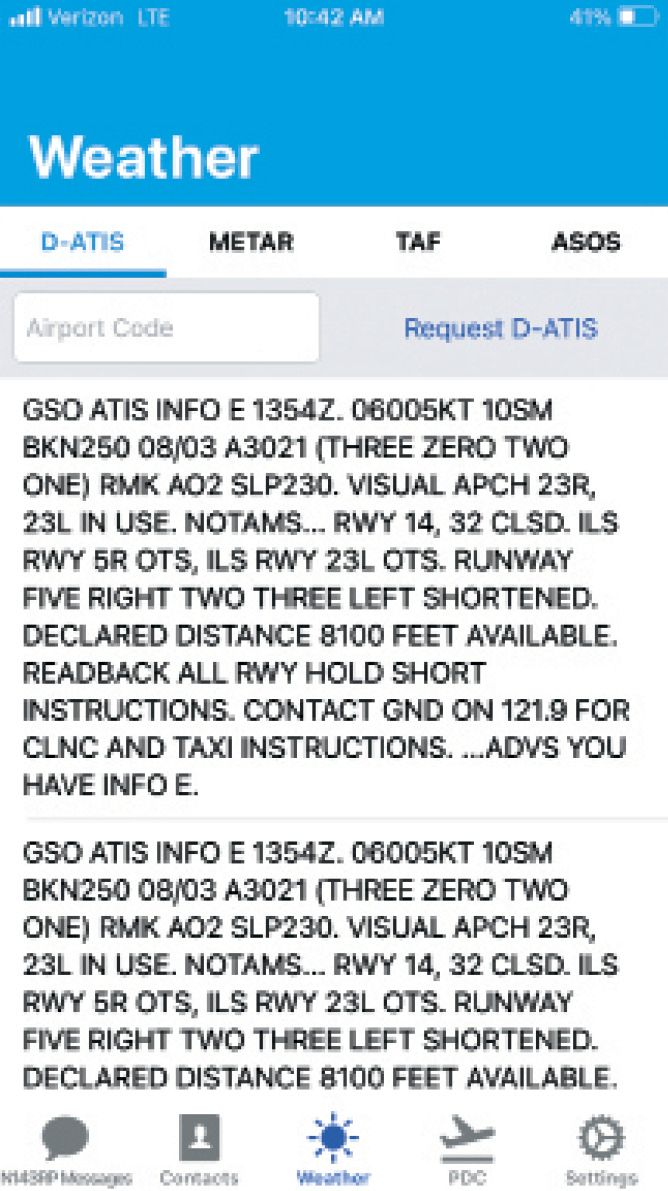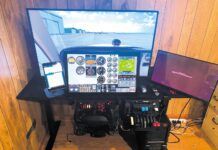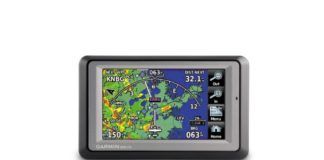Whichever Way Up
In 2013, I was again breaking in a new CFII for an instrument competency check. I was flying a /U C172 at the time without an IFR certified GPS, but I did have WingX with the IFR subscription on my iPad. This subscription gave me geolocated IFR charts on the app. I did some maneuvers, and some approaches. When we returned to the FBO, the instructor told me I did fine, but he would like to fly with me again with just paper charts, no moving map, because he wanted to be sure that “I could fly the needles, and I wasn’t just driving the little blue airplane around on the screen.”
I was surprised the guy hadn’t seen device-based flight maps before, at this point in time around 2009. I told him that I thought it would be hard, maybe impossible, to just drive the little blue airplane because of lag and scale. I did have the nav radios set up correctly, didn’t I? But the best information I was getting from the app was the ground track. So I printed out government charts for two approaches and flew with him the next week for the sign off.
Paul Huffman
White Salmon, Washington
What Altitude?
I’ve been a faithful reader of IFR Magazine for many years, and I can’t tell you adequately how much better, and safer, an IFR pilot it has made me. I personally think it should be required reading for all IFR-rated pilots. There’s so much great information that I never learned in training or after 1500 hours of flying props, helicopters, and jets.
I have been particularly fond of Mr. Elim Hawkins’ articles who provides a glimpse into the world of ATC that is extremely illuminating and certainly not well-covered by instructors—how would they know?—or even other major aviation periodicals. So many times I have read one of his articles and thought to myself: “Oh, that’s why they do it like that,” or “I had no idea this is what goes on in a Center and in the Tower.”
I know that figuring out what to write about for a columnist can be a challenge sometimes, so I was hoping you might forward to Mr. Hawkins one topic I don’t believe he has covered and which I (and others?) am still curious about: altitude discretion when flying into and through Class Bravo under flight following.
In particular, flying into the Dallas Area Class Bravo I know that I have to hear the magic words “Cleared into Bravo airspace,” to come in, but at what altitude? Can I come in at any ol’ altitude, or do they have preferences? Once inside the Bravo under flight following, am I now altitude controlled and can only change altitude when instructed? Or do I automatically have discretion because I am under VFR, as long as I notify them? If I have to ask to change altitude, what is the best way to do that? I haven’t a violation (yet) when flying under flight following in very busy Bravo airspace, but an in-depth examination of how altitude is controlled for flight following aircraft in Bravo, and other airspaces (C, D) as well perhaps, would be a welcome article, I think.
Thanks!
Victor Vescovo
Dallas, Texas
Thanks for the suggestion, Victor. You’re correct in that finding a topic for articles month after month can be quite challenging, so we appreciate all suggestions. We’ve given Elim your suggestion and he ran with it. Check next month’s issue.
While your suggestion centers more on VFR flight, Elim has expanded it to an article covering the same issues for IFR flight while also reaching over to the VFR side.
Another Source for PDC
I read the December article, “PDC: File, Read, Fly,” by Fred Simmons and it seemed like he was saying the only way to get D-ATIS and PDC was through a paid subscription. There’s an app called FBOLink that has the same features as well as the ability to text FBOs, all for free. A friend of mine showed me and I’ve shown it to my 135 employer.
They’ve been using it for two years now with a fleet of 40 airplanes. Not sure if there’s a reason why it’s free and the others are paid but I’ve never seen any ads and I’ve never had issues receiving my PDC through the app. Just search the AppStore for FBOLink messaging and it’s the blue and grey app. Again just thought I’d share that there is a free option that for me works great.
I’m not sure what backend it might use but I just downloaded the app and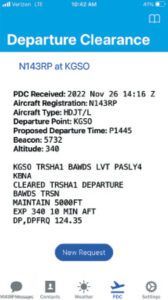 went through the registration process. After the registration is complete (I believe it took a day or two originally) you just open the app and—where available—view D-ATIS and get PDCs after a flight plan has been filed through any service.
went through the registration process. After the registration is complete (I believe it took a day or two originally) you just open the app and—where available—view D-ATIS and get PDCs after a flight plan has been filed through any service.
Adam Nance
Greensboro, North Carolina
In looking at the rather sparse information about the app both on the Apple and Android app stores, no mention is made of anything but messaging the FBO. There is one user comment about D-ATIS, but the app only pushes communication with the FBOs.
On digging into the author’s web site, though, there is a small note, almost as an afterthought, that D-ATIS and PDC are available through the app. If you frequently fly into those larger airports that offer D-ATIS and PDC, this could well be an extremely useful app, although use in the air—usually to get the ATIS as you near the airport—would require some form of cell phone network connectivity.
How to Use AoA
I am a long-time and avid reader of IFR Magazine. I have a question regarding angle of attack (AoA) indicators and their utility in IFR flying, and I was looking for your opinion on it. Recently, at the suggestion of a fellow pilot and various FAA commentaries, I had a Garmin GI-260 AoA indicator installed in my IFR-equipped C172. I am trying to evaluate how this device could be useful in the IFR environment. Four things come to mind, but I have a specific question as to whether the fourth item is really true.
1. Help perform well-stabilized instrument approaches (visual as well), especially with short runways.
2. Help with performing safe circle-to-land maneuvers during an instrument approach.
3. Help with establishing a good and safe rate of climb after a missed approach (VX).
4. If there is airframe icing (but not pitot tube or AoA indicator icing), could an AoA indicator help prevent stalls? It appears that any AOA indicator (including the vane systems used by larger aircraft) would show the correct angle of attack, but would not recognize that the critical angle of attack is now less. In the Garmin system, the indicator could be showing green but could be on the verge of a stall.
I realize this is a long involved email, but I would like your thoughts on this topic. Perhaps an article on the utility of the AOA indicator in IFR flight might be of interest to other readers.
Elliot Perlman
Providence, Rhode Island
First, you need to fly (good VMC) with your new AoA system and observe how it reacts in various configurations and combinations of these configurations: light, heavy, low G, high G, straight and level, steep turn.
You’ll likely find the indications to be eye opening in that in most conditions you’ll have more available lift than you’d expect, but then there are those other situations…
To answer your specific questions:
1. Yes
2. Yes
3. As supplemental information, yes. We’d suggest that your best indication is the pitch change to a missed climb attitude. Use the AoA as a check on configuration—once you think you’ve completed the transition to the missed climb. If the AoA indication is higher or even lower than you’d expect, figure out why and fix it.
4. Ummm, true, but one might ask what you’re doing messing around in ice in a 172? In a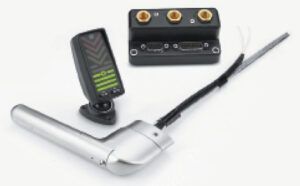 FIKI-certified aircraft, you could go find some ice and compare the AoA readings with the feel of the aircraft. But, lacking FIKI certification, all you can do is increase your awareness. It’s good that you’re considering this, but your best guide is the feel of the aircraft in ice. If the aircraft with ice is feeling sluggish and heavy, and shudders as if close to a stall in good weather, then you’re probably close to the stall and you should remember that as about the limit for being in ice. Note the AoA reading and use that as a guide, yes, but the aircraft feel is your best indication. Note that when in ice, configuration changes are generally a bad idea, so regardless of what the AoA might say, don’t change your flap settings until/unless you’re free of ice or at a higher airspeed.
FIKI-certified aircraft, you could go find some ice and compare the AoA readings with the feel of the aircraft. But, lacking FIKI certification, all you can do is increase your awareness. It’s good that you’re considering this, but your best guide is the feel of the aircraft in ice. If the aircraft with ice is feeling sluggish and heavy, and shudders as if close to a stall in good weather, then you’re probably close to the stall and you should remember that as about the limit for being in ice. Note the AoA reading and use that as a guide, yes, but the aircraft feel is your best indication. Note that when in ice, configuration changes are generally a bad idea, so regardless of what the AoA might say, don’t change your flap settings until/unless you’re free of ice or at a higher airspeed.
Your thoughts about “large aircraft” aren’t exactly correct. Yes, an airframe behaves differently, has different speeds, in ice. But, transport-category aircraft have extensive de-ice systems that are capable of removing extensive ice on critical surfaces.

